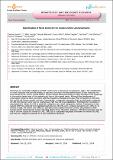| dc.contributor.author | Hayashi, Takuma | |
| dc.contributor.author | Horiuchi, Akiko | |
| dc.contributor.author | Aburatani, Hiroyuki | |
| dc.contributor.author | Ishiko, Osamu | |
| dc.contributor.author | Yaegashi, Nobuo | |
| dc.contributor.author | Kanai, Yae | |
| dc.contributor.author | Zharhary, Dorit | |
| dc.contributor.author | Konishi, Ikuo | |
| dc.contributor.author | Tonegawa, Susumu | |
| dc.date.accessioned | 2018-05-09T18:10:34Z | |
| dc.date.available | 2018-05-09T18:10:34Z | |
| dc.date.issued | 2014-06 | |
| dc.date.submitted | 2013-12 | |
| dc.identifier.issn | 2372-6601 | |
| dc.identifier.uri | http://hdl.handle.net/1721.1/115265 | |
| dc.description.abstract | Sarcomas are neoplastic malignancies that typically arise in tissues of mesenchymal origin. The identification of novel molecular mechanisms leading to sarcoma formation and the establishment of new therapies has been hampered by several critical factors. Human uterine leiomyosarcoma (Ut-LMS) develops more frequently in the muscle tissue layer of the uterine body than in the uterine cervix. Although the development of gynecologic tumors is often correlated with the secretion of female hormones; that of human Ut-LMS does not and its risk factors remain unknown. Importantly, a diagnostic biomarker that can distinguish malignant Ut-LMS from benign tumor uterine leiomyoma (LMA) has yet to be established. Therefore the risk factor(s) associated with human Ut-LMS to establish a diagnosis and novel therapeutic method. Proteasome b-ring subunit LMP2/b1i-deficient mice spontaneously develop Ut-LMS, with a disease prevalence of ~40% by 14 months of age. We shown that LMP2/b1i expression was absent in human Ut-LMS, but present in other human uterine mesenchymal tumors including uterine LMA. Therefore, defective-LMP2/b1i expression may be one of the risk factors for human Ut-LMS. LMP2/b1i is a potential diagnostic biomarker for human Ut-LMS, and may be a targeted-molecule for a new therapeutic approach. | en_US |
| dc.publisher | Open Access Pub | en_US |
| dc.relation.isversionof | http://dx.doi.org/10.14302/ISSN.2372-6601.JHOR-13-379 | en_US |
| dc.rights | Creative Commons Attribution 4.0 International License | en_US |
| dc.rights.uri | http://creativecommons.org/licenses/by/4.0/ | en_US |
| dc.source | Journal of Hematology and Oncology Research | en_US |
| dc.title | Identification Of Novel Biomarker For Human Uterine Leiomyosarcoma | en_US |
| dc.type | Article | en_US |
| dc.identifier.citation | Hayashi, Takuma et al.“Identification Of Novel Biomarker For Human Uterine Leiomyosarcoma.” Edited by Krzysztof Roszkowski. Journal of Hematology And Oncology Research 1, 2 (May 2014): 8–13 © 2014 Takuma Hayashi et al | en_US |
| dc.contributor.department | Massachusetts Institute of Technology. Department of Biology | en_US |
| dc.contributor.department | Picower Institute for Learning and Memory | en_US |
| dc.contributor.mitauthor | Tonegawa, Susumu | |
| dc.relation.journal | Journal of Hematology and Oncology Research | en_US |
| dc.eprint.version | Final published version | en_US |
| dc.type.uri | http://purl.org/eprint/type/JournalArticle | en_US |
| eprint.status | http://purl.org/eprint/status/PeerReviewed | en_US |
| dc.date.updated | 2018-05-09T17:24:50Z | |
| dspace.orderedauthors | Hayashi, Takuma; Horiuchi, Akiko; Aburatani, Hiroyuki; Ishiko, Osamu; Yaegashi, Nobuo; Kanai, Yae; Zharhary, Dorit; Tonegawa, Susumu; Konishi, Ikuo | en_US |
| dspace.embargo.terms | N | en_US |
| dc.identifier.orcid | https://orcid.org/0000-0003-2839-8228 | |
| mit.license | PUBLISHER_CC | en_US |
